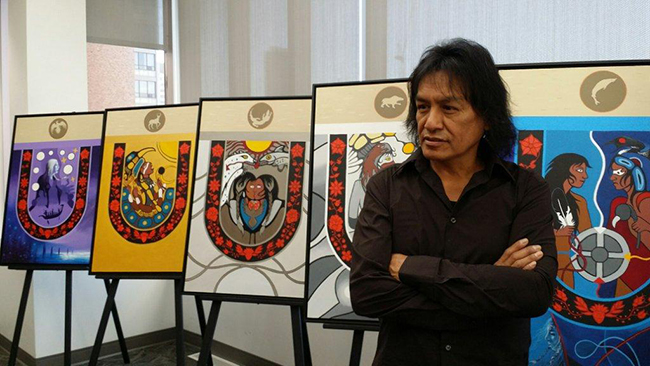The Anishinawbe way of life depicted in paintings

By Barb Nahwegahbow
TORONTO – “I have a great respect for Joseph Sagaj, he’s one of the best Anishnawbe artists we have,” said Elder Jim Dumont.
Dumont was speaking last month at the unveiling of a series of seven paintings commissioned by the provincial Ministry of the Attorney General (MAG). The event was held at the MAG offices on Bay Street in Toronto. The Honourable Yasir Naqvi, the Minister of the Attorney General was in attendance along with Assistant Deputy Attorney General Kim Murray, MAG staff and community members. People crowded into the room for the much-anticipated event until it was standing room only.
The artist Joseph Sagaj, from Neskantaga First Nation took well over a year to do the paintings that depict the Seven Stages of Life. During that time, he attended traditional teachings, consulted with elders and reflected on the teachings. Dumont was one of the elders involved in the process.
“If you could see everything that’s in these paintings,” said Dumont, “you would have a very special glimpse into the Anishinawbe mind, the Anishinawbe world view.” Not only did Sagaj include the Seven Stages of Life teachings in his paintings, he also included teachings about the seven gifts and the clans. “I have never seen anyone try to do that before,” Dumont said.
The paintings are vibrant with wonderful colours, yet gentle in their depiction of Anishnawbe teachings. The beauty of the Anishnawbe way of life and living has been communicated in the artist’s every brush stroke, his choice of colours and the people depicted. What I’ve shown, Sagaj said at the event, is how we conduct our everyday lives. The paintings are not just something executed on canvas, he said. “To me, they’re about ceremonies.”
“Art prompts us and provokes us,” said Minister Naqvi. “The role of art and culture is to ask questions, to have a better understanding…having this art form which depicts the Seven Stages of Life will serve as that very important conversation in our workplace so that people can better understand the Indigenous traditions, Indigenous cultures that we have not taken the time, frankly, to understand.”
The works are a significant departure for Sagaj who has become best known for his soft watercolour landscapes and lately, his abstract works. When he was a youngster, he learned about the big-name Indigenous artists, he said, people like Norval Morrisseau, Carl Rae, Arthur Shilling and Carl Beam. When he saw their paintings, Sagaj thought to himself, “Geez! I wish I could become like them. These guys can paint.” Sagaj has joined their ranks.
If we are Anishinawbe, it should be visible in our way of speaking and our way of seeing, our way of doing art and our way of writing, said Jim Dumont. “If you are Anishinawbe, there’s a uniqueness in that that should be visible. My view of what an Anishnawbe artist is – it’s a very high standard. But I hold Joseph up to be one of those true Anishinawbe artists that we have in the world today,” he said. “This,” he said, pointing to the paintings, “is the visible evidence of that.”
Sagaj attached one of the Seven Gifts and one of the Clans to each one of the Life Stages in his paintings. Dumont spoke briefly about each painting, and he acknowledged that talking about each element in the paintings can take an infinite amount of time.
People will walk by these paintings and wonder about them and create conversations around them, Dumont said. That will cause change to happen, he said, and then maybe we can work together towards achieving something.
The work will be on permanent display in the fourth floor boardroom at the Ministry of the Attorney General’s offices on Bay Street in Toronto. Sagaj hopes there will be an opportunity for the community to view the paintings and to hear the teachings from Jim Dumont.


